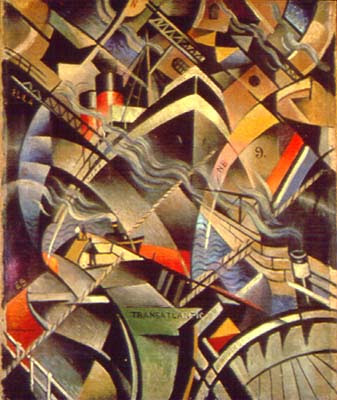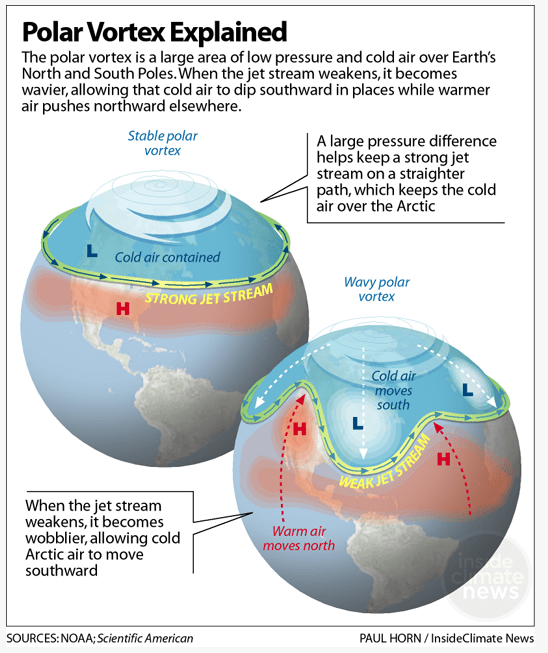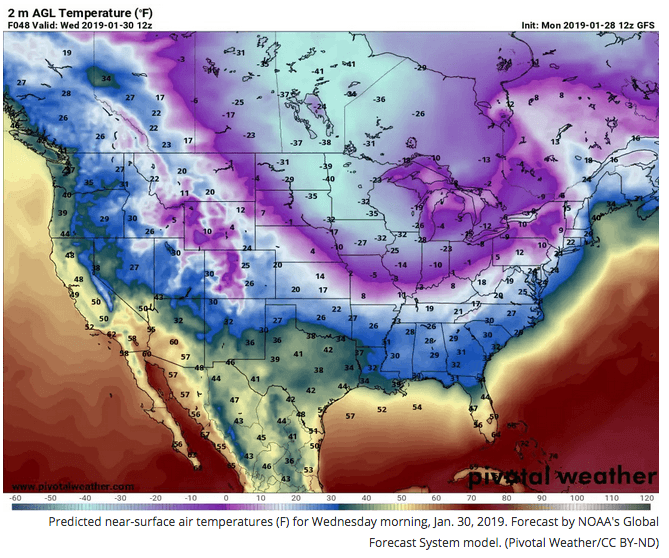I woke up this morning to a temperature of -26 degrees Fahrenheit with a wind chill of -48 degrees or so. That’s cold. The meterologists are calling this a polar vortex. But what is that exactly?
According to an article at Business Insider called A Polar Vortex is Engulfing the US. Here’s what that really means and why these events might be getting more common , “The term polar vortex describes the mass of low-pressure cold air that circulates in the stratosphere above the Arctic and Antarctic regions. Sometimes the circulation of the polar vortex weakens during the winter, causing surges of frigid air to splinter off and drift south. The freezing air is carried by the jet stream, a current of wind that extends around the hemisphere and divides the air masses in the polar region from those farther south. ”
In the picture above (here is a link to InsideClimate News), you can see the difference between a stable polar vortex and a wavy polar vortex. What is happening in my state today is not typical. The jet stream is weak and because of it warm air moves north in spots and cold air moves south in others.
The image used to indicate the polar vortex is interesting. There is this sense of swirling movement. Now I’m curious about the word <vortex>. What other words is it related to? Off to Etymonline I go!
It was first attested (first time we see this word in print) in the 1650’s. At that time it was used to mean “whirlpool, eddying mass.” Earlier than that it was from Latin vortex, a variant spelling of vertex “an eddy of water, wind, or flame; whirlpool; whirlwind.” The Latin variant vertex is from the stem of the Latin infinitive vertere “to turn.”
Using what I know about the principle parts of the Latin verb (verto, vertere, verti, versus), I spot the two Latin stems that have become modern English bases (<vert> and <verse>). Now I can list words that share these bases and this denotation of “turn, turn around.” Stop and think about each of the following words. Do you see this base and do you sense the denotation in the word’s present day meaning?
adverse anniversary
avert controversy
divert convert
extrovert invert
reverse transverse
universe versatile
versus vertebra
vertigo
There are more, of course, but I just wanted to give you an idea of the connectedness of these words that share a base and a denotation – words that form a family. I’ve colored coded the two bases because even though these two bases derive from the same Latin verb, they are spelled different and would need to be represented on two different matrices. They are etymological relatives.
Back to <vortex>
But let’s get back to <vortex>. Does it have any interesting morphological relatives (meaning words from the same ancestor that share the same base spelling presently)? For this I went to Word Searcher first. Besides vortex, vortices and vortexes, I found cavort, cavorts, cavorted, and cavorting. Hmmm. They might share a base, but a <ca> prefix? I’m not so sure about that. I headed back to Etymonline to investigate:
cavort (v.)
1793, cauvaut, “to prance, bustle nimbly or eagerly,” American English, of uncertain origin, sometimes said to be an alteration of curvet “a leap by a horse,” a word from French that is related to curve (v.). Or perhaps from ca-, ka–, colloquial intensive prefix + vault (v.) “to jump, leap.” Modern form attested by 1829. Related: Cavorted; cavorting.
1653 H. More Def. Philos. Cabbala (1713) App. i. 113 That there are infinite numbers of Atoms or Particles, different in magnitude and figure;..and that they are moved in the Vniverse after the manner of vortices.
Here is an example of its use from 1704 with a sense of strong swirling.
1704 J. Pitts True Acct. Mohammetans vii. 77 In this place is much Danger without a fresh Gale of Wind, because it is a kind of Vortex, the Water running whirling round, and is apt to swallow down a Ship.
Here is a rather poetic use from 1700 or so.
a1700 T. Ken Edmund in Wks. (1721) II. 24 Now the North Wind the crazy Vessel sweeps, And in its rapid Vortex pris’ner keeps.
So we see this same action of spinning and swirling whether the vortex be involving fire, water, wind, atoms or anything. That denotation of “to turn, turn around” is present in every use. Next up some unexpected words that share this base!
vorticella
This word is a noun that was coined in Modern Latin with a diminutive sense. The OED defines it as an individual belonging to the genus Vorticellidae and gives this use from 1875.
1875 T. H. Huxley & H. N. Martin Course Elem. Biol. (1877) 90 Sometimes a rounded body, encircled by a ring of cilia but having otherwise the characters of a Vorticella bell, is seen to be attached to the base of the bell of an ordinary Vorticella.
Wikipedia describes the organism this way: “The organism is aptly named “Vorticella” due to the beating cilia creating whirlpools, or vortices.”

The camera catches the vortex of cilia on either side, but if you look closely you can see the blurring action of all the cilia that surround the opening. The movement stirs the water and promotes the flow of food to the organism. What I find especially striking about this is that I have seen this organism before! Yes! I have! My husband worked for a neighboring water treatment plant as a research biologist for many years. At one point, he recorded video of what he could see in his microscope when it was magnified 400 times. When my students studied the classification system and wondered what protists looked like, I showed them videos of this very organism. How about that?
vorticism
The OED defines this as “A British art-movement of the early twentieth century, characterized by abstractionism and machine-like forms.” How interesting that this base show up in art! The following use listed at the OED is quite entertaining.
1915 Drawing July 56/1 Vorticism..is in reality our old and amusing friend Cubism, but Cubism heavily charged with electricity.
More information from Wikipedia reveals that “it tried to capture movement in an image. In a Vorticist painting modern life is shown as an array of bold lines and harsh colours drawing the viewer’s eye into the centre of the canvas.”

http://radio.garden/live/toulouse/radiopresence
The cover of the 1915 BLAST
The cover of the second (and last) edition of BLAST, by Wyndham Lewis and friends. This edition included an article by Henri Gaudier-Brzeska written and submitted from the trenches of WWI.

Image Credit: http://www.artnet.com/Magazine/news/walrobinson/walrobinson2-1-40.asp
The Poetry Foundation includes in their information that Ezra Pound coined the word “vorticist” and felt that it applied to all of the arts. Here is a quote from his writing about this, “You may think of man as that toward which perception moves. You may think of him as the TOY of circumstance, as the plastic substance RECEIVING impressions. OR you may think of him as DIRECTING a certain fluid force against circumstance, as CONCEIVING instead of merely observing and reflecting.”
Here is a vorticist poem by H.D. (Hilda Doolittle)
Whirl up sea —
Whirl your pointed pines,
Splash your great pines
On our rocks,
Hurl your green over us,
Cover us with your pools of fir.
According to The Poetry Foundation, the Vorticist Movement ended just three year after it began. There is thought that the toll of World War I had much to do with that.
vorticular
This is an adjective describing something as in a swirling motion.
1891 Atlantic Monthly LXVIII. 68/2 They [sc. tornadoes] possess truly vorticular motion.

vortoscope
This was an invention by A.L. Coburn in 1916. It was used in photography. The following sentence is from the OED.
1966 A. L. Coburn Autobiogr. ix. 102 I aspired to make abstract pictures with the camera. For this purpose I devised the Vortoscope late in 1916. This instrument is composed of three mirrors fastened together in the form of a triangle… The mirrors act as a prism splitting the image formed by the lens into segments.
Here is one of vortocist A.L. Coburn’s photographs using his vortoscope. The finished picture is called a vortograph.


Here are some pretty cool modern examples from dasascukaphotoblog .


Final Thoughts
It’s makes sense that this word, this family, would be used in so many interesting situations. The bases <vort>, <vert>, and <verse> are as close as siblings. They share a denotation that reverberates through the many many words that share those bases. Today I focused on that shared meaning and the spirit of human nature to see certain characteristics of the world around us and to apply those characteristics to creative expression. When I was looking in the OED, I also found that there were words in the <vort> family that have become obsolete. One that struck my fancy was <vorticordious> meaning “turning the heart.” The only use listed at the OED was from 1669. I can imagine someone being vorticordious as easily as I can picture someone who, as we now say, turns heads. Uncovering this cool word is a reinforcement that our language is not static. It is living and being shaped, as it always has been, by the people who speak it.
And now, I will turn my attention back to the polar vortex at hand with a new appreciation for the lines, the flow, the turning movement that the polar vortex brings to this temperature map. Stay warm!



Mrs. Steven,
This is an amazing post. Do you mind if I share this with my Koshkonong Trails Students? This could help inspire future projects!
Thank you! Please feel free to share with your students. Some of them will be familiar with the resources I use because they have used them in my classroom! This year I am using the Oxford English Dictionary for the first time. They offered it free to educators and I jumped on that opportunity. Let me know if you want the username and password for our school district.
Wow, Mary Beth! That is quite a post! (Worthy, if I may say, of Ann Whiting for its expansive artfulness). What a great way to stay warm on a snow day!
Thank you. Ann’s work is definitely something I’ve always been inspired by. To be compared to her is high praise indeed!
This polar vortex information is interesting…but I’d sure like it to move on out!!
The longer it hangs around, the more that can go wrong because of it. These temperatures are scary for sure.
Fabulous post! Thanks for sharing!
Thank you!
Fantastic! I loved everything about this blog post … so interesting!!
Thank you, Kathy. It was fun to spend time in the OED this time and find interesting relatives I wouldn’t have seen elsewhere!